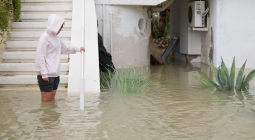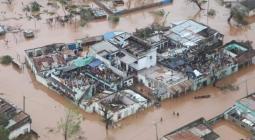People 'jump from roof to roof' as floods kill 148 in Nepal
Major floods and landslides in Nepal have killed at least 148 people and injured more than 100 across the Himalayan nation, police have reported.
They say more than 50 people were still missing on Sunday, after two days of intense rainfall which inundated the valley around the capital, Kathmandu. About 3,600 people have been rescued so far.
Residents say they "jumped from one roof to another" to escape rising waters, which have flooded thousands of homes. Meanwhile, crews continue to carry out rescues on helicopters and inflatable rafts.
Despite rain being forecast to continue through to Tuesday, there were signs of some easing on Sunday.
Some residents were able to return to their mud-caked homes, while others are still cut off with major roads between towns and villages still blocked.
But flash floods and landslides have caused a growing number of deaths.
At least 35 bodies have been recovered from vehicles buried under landslide in Prithvi Highway, near Kathmandu, police officials say.
Most major motorways connecting Kathmandu with the rest of the country remain blocked in multiple places by landslides.
Five people, including a pregnant woman and a four-year-old girl, died when a house collapsed under a landslide in the city Bhaktapur, to the east of Kathmandu, state media reported on Saturday.
Two bodies were removed from a bus buried by a landslide in Dhading, west of Kathmandu. Twelve people, including the driver, were said to be onboard.
Six football players were also killed by a landslide at a training centre operated by the All Nepal Football Association in Makwanpur, to the south-west of the capital.
Others have been swept up in the floodwaters. In one dramatic scene, four people were washed away by the Nakkhu River in the southern Kathmandu valley.
"For hours, they kept on pleading for help," Jitendra Bhandari, an eyewitness, told the BBC. "We could do nothing."
Hari Om Malla lost his truck after it was submerged by water in Kathmandu.
He told the BBC that water had "gushed" into the cabin as the rain intensified on Friday night.
"We jumped out, swam, and got away from it - but my purse, bag and mobile have been swept away by the river. I have nothing now. We stayed the whole night in the cold."
Another person, Bishnu Maya Shretha, said the scale of flooding was more extreme this season.
"We had run away the last time, but nothing happened. But this time all the houses were flooded.
"As the water levels rose, we had to cut the roof and get out. We jumped from one roof to another and finally reached a concrete house."
Government spokesman Prithvi Subba Gurung told the state-run Nepal Television Corporation the flooding had also broken waterpipes, and affected telephone and power lines.
According to state media, 10,000 police officers, as well as volunteers and members of the army, have been mobilised as part of search and rescue efforts.
The Nepalese government urged people to avoid unnecessary travel, and banned driving at night in the Kathmandu valley.
Air travel was also affected on Friday and Saturday, with many domestic flights delayed or cancelled.
Monsoon season brings floods and landslides every year in Nepal.
Scientists say, though, that rainfall events are becoming more intense due to climate change.
A warmer atmosphere can hold more moisture, while warmer ocean waters can energise storm systems, making them more erratic.
Cover photo: Police rescue stranded people using a zipline in Lalitpur, Nepal



